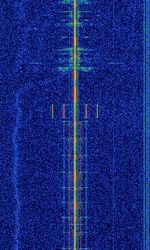UTC (Coordinated Universal Time) Time Standard
 | |
|---|---|
| Frequencies | 2.5 MHz,25 MHz,5 MHz,10 MHz,15 MHz,20 MHz |
| Frequency Range | 2.5 MHz - 25 MHz |
| Mode | AM |
| Modulation | — |
| ACF | — |
| Emission Designator | — |
| Bandwidth | 4 kHz |
| Location | United States |
| Short Description | UTC (Coordinated Universal Time) time standard transmission from NIST (National Institute of Standards and Technology) stations WWV in Fort Collins, Colorado USA (2.5, 5, 10, 15, 20, 25 MHz) and WWVH in Kauai, Hawaii (2.5, 5, 10, 15 MHz). |
| I/Q Raw Recording | Download file |
| Audio Sample | |
UTC (Coordinated Universal Time) time standard transmission from NIST (National Institute of Standards and Technology) stations WWV in Fort Collins, Colorado USA and WWVH in Kauai, Hawaii. Transmission consists of voice and time coded reference markers. Used for time reference. Also used by NOAA to broadcast marine storm warnings and geophysical alerts at 18 minutes (WWV) and 45 minutes (WWVH) after the hour. Please note that the 25 MHzMegaHertz (MHz) 10^6 Hz transmission is experimental. Note that WWV uses a male voice, WWVH uses a female voice.
The broadcast information includes time announcements, standard time intervals, standard frequencies, UT1 time corrections, a BCD time code, and geophysical alerts. As of April 19, 2019, the stations also announce upcoming and current Military Auxiliary Radio System (MARS) and U.S. Department of Defense (DoD) exercises.
- A BCD time code is continuously broadcast on a 100 HzHertz (Hz), unit of frequency, defined as one cycle per second (1 Hz). subcarrier.
Frequencies[edit]
- 2.5 MHzMegaHertz (MHz) 10^6 Hz (WWV, WWVH)
- 5 MHzMegaHertz (MHz) 10^6 Hz (WWV, WWVH)
- 10 MHzMegaHertz (MHz) 10^6 Hz (WWV, WWVH)
- 15 MHzMegaHertz (MHz) 10^6 Hz (WWV, WWVH)
- 20 MHzMegaHertz (MHz) 10^6 Hz (WWV only)
- 25 MHzMegaHertz (MHz) 10^6 Hz (WWV only; experimental basis - may be interrupted or suspended without notice)
Phone number Info[edit]
There are also two respective phone numbers that exist in which any person can call directly, either through a cell phone, landline, etc. to listen to the signal itself, in case if there is no reception of the respective frequencies. The delay before the sync between VoIP calls is about 150ms, while landlines are much closer to 0. WWV: +1 (303)499-7111. WWVH:+1 (808)335-4363.
Once the call is forwarded, the time code will actually be synced with your cell phone's time, along with the time elapsed of the call. The call disconnects after two minutes to save on costs, and possibly for others who wish to dial in to hear.
Dial up modems can also use a reference with this signal by dialing in. The transmitter will actually spit out a text-based time code based off the same BCD via the modem's audio carrier to the terminal window (if connected via BBS).
Samples[edit]
Decoding Software[edit]
- Hobby Level Software
- Bonito Radiocom6
- Bonito RadioJet Decoder (in German)
- Sorcerer
- Professional Level Software
Website Link[edit]
Antennas[edit]
There are five antennas total, one for each frequency. Each antenna is a half-wave vertical to radiate in an omni-directional pattern.